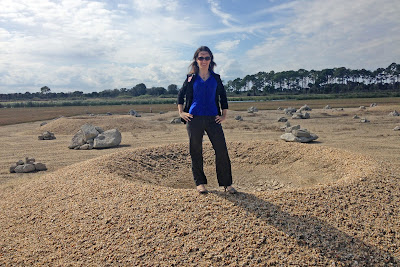It's refreshing to
have an honest conversation about human spaceflight. I've written
here previously about my frustrations that future human spaceflight
hype discredits missions and makes it harder for us in the space
world to do our jobs. Spaceflight is difficult, expensive, and takes
time. Well-intentioned promoters downplay these challenges, but
reality backfires on them. I'm an idealist by nature, but when it
comes to the business and technical challenges of space, I'm a
realist bordering on skeptic. Show me the detailed plan, show me the
money, and show me how the technology is already being developed and
tested.
It has been a
pleasure to delve into realistic human spaceflight architectures at
the Buzz Aldrin Space Institute this week. Only by detailing, step-by-step, a feasible and affordable means of creating a
sustainable path to humans living on another world (Earth's Moon,
Mars' moons, Mars itself, etc.) with a business case for industry profit can
we accomplish such a monumental task. Apollo to the Moon was a
one-time effort in history which will not and arguably should not be
repeated. For decades, many in the space industry have known that
sustainability (settlement, colonization, pioneering, establishing a
base or outpost, whatever you want to call it) is what is needed. But
there has never been a consensus on how to do it.
In-situ resource
utilization (ISRU) is not a new concept but is surprisingly an
under-appreciated and under-funded area of study. Instead of needing
to bring all resources with us on a rocket from Earth to wherever
we're going, it would save a lot of weight (which translates to fuel
savings, which translates to money savings) to use the resources that
exist in space already. Although it has been politically unpopular to
say so for years, a heavy lift rocket such as the Space Launch System
is likely not needed if we instead focus on ISRU.
To use two examples
that we discussed today at BASI, if we can use lunar and/or Martian
regolith (dirt) to create water and rocket fuel/propellant, we would not have to
bring extra water and fuel with us on these missions. Existing
water/ice H2O can be extracted from the regolith. Electrolysis
can break H2O into hydrogen H2 and oxygen O2 which can be used as
fuel. All that is needed is energy. On Mars, carbon dioxide CO2 is
also available in the atmosphere for ,making fuel.
There are multiple
unanswered questions that need to be studied in order to propose this
course of action. How do we best mine this regolith, especially the
icy regolith? Can and how do we break apart the regolith and ice to extract the elements needed? How much energy
would it take? How pure does the water and fuel need to be? Can and
how do we create a usable fuel? How much would we save launching from
the Moon compared to launching from Earth with Earth's higher gravity?
So many questions, too little done in experimentation!
Thankfully,
planetary regolith experimentation is one of my things, and I find
this all to be exciting questions to ponder and later to test.
Unfortunately, so far there hasn't been an organized and
collaborative effort. There are scattered teams working on ISRU at
NASA centers, universities, and even a few commercial companies, but
no one seems to be talking to each other in a productive way to move
the field forward. Thankfully, building collaborations is also one of
my things. Today's meeting was fun and I look forward to bringing
together even more people to advance this effort and get things done!
Money is the main
barrier, as it always is. Aside from NASA, I don't know of anyone
willing to fund these efforts, and NASA money is scarce. Without much
funding, ISRU demonstration progresses at a snail's pace and the
concepts and technology won't be ready for prime time when missions
are being planned. Of course, missions are also endlessly delayed, so this isn't urgent.
Here's where my optimism returns: I believe that public-private
partnerships will return humans to other worlds in my lifetime. In
fact, I'm holding on to the dream that I'll be among the astronauts
to walk on another planetary body. I'm working hard to do my little
part to get us there in whatever way I can.
 |
| What can we do with lunar regolith? - NASA KSC, January 22, 2015 |




